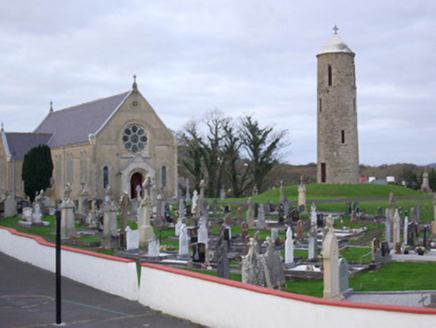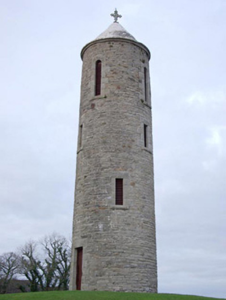Survey Data
Reg No
40909836
Rating
Regional
Categories of Special Interest
Architectural, Social
Previous Name
Killaghtee Catholic Parish Church
Original Use
Church/chapel
Date
1840 - 1880
Coordinates
174865, 377087
Date Recorded
10/11/2011
Date Updated
--/--/--
Description
Freestanding four-stage belltower/belfry on circular-plan associated with the Catholic Church of SS Joseph & Conal (40909801), built c. 1860, having conical ashlar roof over with cut stone eaves course and crowned with carved stone Celtic cross finial. Roughly coursed rubble stone walls. Square-headed window openings to the second and third stages having rock-faced block-and-start surrounds with dressed margins, rock-faced sills with dressed margins, and timber louvers. Segmental-headed openings at fourth stage/belfry level having rock-faced block-and-start surrounds with dressed margins, rock-faced sills with dressed margins, and timber louvers. Square-headed doorway to the south elevation having rock-faced block-and-start surrounds with dressed margins, rock-faced sills with dressed margins, and modern timber door. Located in a prominent location on an elevated site within the grounds/graveyard of associated church, to the east of the main edifice, and to the north-east of Bruckless/south of Milltown.
Appraisal
This prominent and well-detailed belltower associated with Catholic Church of SS Joseph & Conal (40909801) is a local landmark and an interesting addition to the built heritage of the local area. It is constructed in the form of an early Medieval round tower, harking back to the golden era of the Church in Ireland, which is an appropriate form for an ecclesiastic structure of its type. It is robustly-built using local rubble stone and has high quality rock-faced masonry to the openings and smooth ashlar detailing to the conical roof that is clearly the work of skilled masons, and helps to give this structure a strong architectural character. This structure was originally built to serve an earlier Catholic church to site, which was described by Lewis in 1837 as in the ‘course of erection'. This church later burnt to the ground in 1912 resulting in the construction of the new chapel adjacent. Rowan (1979) suggests that this tower was rebuilt in the nineteenth-century on older foundations, although it is not recorded as an archaeological structure. The use of rock-faced masonry is reminiscent of railway and bridge architecture in Ireland dating from c. 1860 – 1880, which suggests it was originally built around this time. Freestanding belltowers are a feature found at many early post-Catholic Emancipation churches in Ireland, which is indicative of the relative lark of resources available to the church at the time. This fine structure is a prominent landmark along the main road from Donegal Town to Killybegs, and forms an interesting pair of related structures along with the associated adjacent church.



